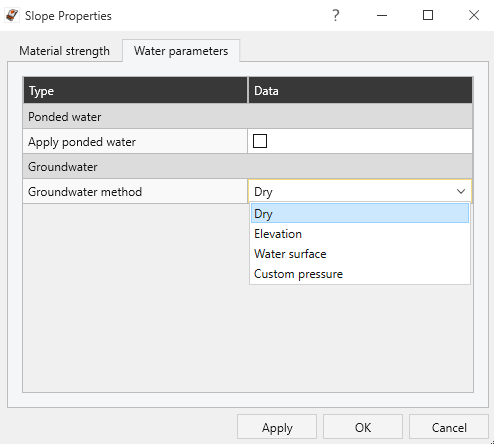Joint Water Pressure
Joint Water Pressure is determined by the Groundwater settings in the Slope Water Parameters dialog.
To set the Groundwater settings:
- Select Home > Slope > Properties

- The Slope Properties dialog will open. Select the Water Parameters tab in the main dialog area.
- The Groundwater Method can be selected from a drop-down list of options, which are explained in detail below:
- Dry
- Elevation
- Water Surface
- Custom Pressure
- Dry
- Depending on the selected Groundwater Method, different parameters such as Water Unit Weight and Hu will be available in the Slope Water Parameters tab. See the following sections for more information on these parameters.
- Select OK or Apply to recompute the analysis with the new water pressure applied. By default, the selected Groundwater Method is applied to all Joint Properties.

Groundwater Method
The Groundwater Method can be set in the Water Parameters tab of the Slope Properties dialog as described above. The selected Groundwater Method can be applied to Joints and Tension Cracks as desired.
Dry
By default, the Groundwater Method is set to Dry. This option represents no water pressure in the analysis.
Elevation
The Elevation option defines the Groundwater level as the height of the water surface according to the origin point. Hydrostatic forces are applied to all joint surfaces below the user-defined Groundwater Elevation value.
Users can also set custom Water Unit Weight and Hu values for this option.
Water Surface
The Water Surface option works in conjunction with the user-defined Phreatic Surface. Setting the Groundwater Method to Water Surface allows the program to check for a Phreatic Surface, then apply the computed water pressure based on it.
Users can also set custom Water Unit Weight and Hu values for this option.
Custom Pressure
The Custom Pressure option allows you to specify the actual average water pressure on each plane, independently. This may be useful if actual water pressure data is available on the failure planes of the wedge. However, remember that these are still average values, and only one value may be specified for each plane (Joint 1, Joint 2, Tension Crack, Basal Joint).
When the Custom Pressure option is selected, users may add a custom Joint Pressure to a Joint Property (using the Joint Water Parameters dialog) or a Tension Crack, if applied. Water Unit Weight and Hu values cannot be set for Custom Pressure models.
Water Unit Weight
The Water Unit Weight is used to determine:
- The calculated water pressure on the joints
- The unit weight of water used to calculate the hydrostatic force in a water-filled or partially water-filled Joint.
The default value of the Water Unit Weight is determined by the Units of Measurement selected in Project Settings (9.81 kN/m3 for metric units, 62.4 lbs/ft3 for Imperial Units). However, you may change this value if necessary.
The Water Unit Weight parameter is applicable for Elevation and Water Surface Groundwater Methods, but not the Custom Pressure option.
Hu
The Hu parameter is simply a factor between 0 and 1 by which the nominal calculated water pressure is multiplied to obtain the actual pressure.
- The default value (Hu = 1) indicates hydrostatic conditions
- Hu = 0 would be equivalent to a dry slope (zero pressure)
- Intermediate values of Hu (between 0 and 1) could be used to simulate head loss due to groundwater seepage if water flow is occurring in the rock slope.
The water pressure values calculated from the pressure distribution models described above are multiplied by the Hu factor to obtain the final pressure used in the wedge stability calculations. The Hu parameter in RocSlope2 is the same as defined in the Rocscience programs Slide2 and RS2.
The Hu parameter is applicable for Elevation and Water Surface Groundwater Methods, but not the Custom Pressure option.